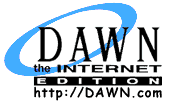
 George Bush's Day in India, Through Pakistani Eyes
How does Pakistan see the blossoming of relations between Delhi and Washington? This detailed account of George Bush's first day in India gives the reader some idea. From The Dawn newspaper of Pakistan.
George Bush's Day in India, Through Pakistani Eyes
How does Pakistan see the blossoming of relations between Delhi and Washington? This detailed account of George Bush's first day in India gives the reader some idea. From The Dawn newspaper of Pakistan.
By Jawed Naqvi
March 1, 2006
Home Page (English)

NEW DELHI, March 1: U.S. President George W. Bush arrived on his maiden visit to India on Wednesday, amid unprecedented secrecy and encircled by raging nationwide protests against his country's occupation of Iraq.
In his talks with Prime Minister Manmohan Singh, a civilian nuclear agreement, efforts to boost bilateral trade to $40 billion within three years and a political dialogue to deepen Indo-U.S. strategic ties are expected to be the main plank.
An international survey of the energy situation, a look at India's ties to Pakistan, Afghanistan, Iran and China, and ways to resolve the Kashmir dispute will also be taken up for serious discussion, official sources said.
Perhaps for the first time, television pictures were not allowed to be broadcast, as America's Air Force One touched down at around 7:30pm at the Indira Gandhi International Airport, just a short while after taking off from Kabul. In March 2000, President Bill Clinton had gone to Pakistan from Mumbai amid similar levels of secrecy.
An unusually massive half million protesters, mostly belonging to the Jamiat ul Ulema-i-Hind had gathered at Delhi's historic Ramlila Grounds, the milling crowd running more than a mile deep. The placards told President Bush to go back home, that he was not welcome in India.
Traffic was at a standstill for hours on the main arterial roads. Dalit leaders, farmers and peasants, in addition to small shopkeeper representatives were among those who expressed their anger at the visit.
 An Ariel View Shows Protesters
An Ariel View Shows Protesters
Demonstrating
Against U.S. President
George W. Bush
in Mumbai, March 2.
Both Leaders Burned in Effigy in Front
of the U.S. Consulate in Cacutta, March 2.


 Some of the Scenes From Nationwide
Some of the Scenes From Nationwide
Protests Yesterday. (above and below)

 ----------------------------------------------------
----------------------------------------------------
Communist leader Prakash Karat, one of the key architects of the protests, said that about a thousand rallies were planned across India for Thursday, including another major event at the Ramlila Grounds, when President Bush opens official talks with Prime Minister Manmohan Singh.
Most pro-Bush spin doctors and news channels sought to suggest that Dr. Singh had broken protocol to receive the American president at the airport. However, Dr. Singh had similarly broken protocol in January, if that is what he did, when he received Saudi King Abdullah also on his first visit here.
President Bush and his wife Laura were greeted at the airport by Dr. Singh and his wife, Gursharan Kaur. The delayed pictures showed him being introduced to Indian National Security Advisor M.K. Naraynan, who was later locked in talks with his U.S. counterpart, Stephen Hadley. There were whispers of a likely breakthrough in the nuclear deal, with India possibly allowed to keep its fast breeder reactors out of the civilian facilities list.
Separating India's tightly entwined civilian and military nuclear programs is key to the deal, because the United States has only agreed to recognize India as having a civilian nuclear program, not as a legitimate nuclear weapons state.
The pact would allow the United States to provide nuclear technology and fuel, desperately needed by India to fuel its booming, energy-starved economy. In return, India has pledged to separate its programs and open the civilian sector to international inspection.
Some Indian opponents see it as an attempt to undermine the country's nuclear weapons program.
The U.S. is India's largest trading partner and foremost export destination. At present, it accounts for 16.48 percent of India's exports and around 6.26 percent of its imports. India accounts for only about 1.06 percent of America's total imports and exports.
There is huge untapped potential for increased bilateral trade. The major items that India exports to the U.S. are: gems & jewelry; readymade garments (cotton) & accessories; manufactures of metals'; and drugs, pharmaceuticals and fine chemicals.
After a brief welcoming ceremony, President Bush was escorted to a limousine, and the motorcade headed for the Hotel Maurya Sheraton, his home in India during his stay here. U.S. Secretary of State Condoleezza Rice, National Security Adviser Stephen Hadley followed him.
Congress Party president Sonia Gandhi and Leader of Opposition L K Advani will call on President Bush, after which President A.P.J. Abdul Kalam will host a banquet in his honor on Thursday.
Earlier at a surprise stop at Kabul, President Bush said that U.S. negotiators were trying to iron out differences with their Indian interlocutors from aboard Air Force One to wrap up an agreement for implementation of the landmark nuclear deal.
 If Bush Went Native
If Bush Went Native
--------------------
 President Bush (C) and First Lady Laura Bush (R)
President Bush (C) and First Lady Laura Bush (R)
Arrive at the Rashtrapati Bhavan [Presidential Palace].
Alongside President Bush is Indian President Abdul
Kalam (2nd R), and India's Prime Minister Manmohan
Singh and his wife Guesharan Kaur (L).
-----------------------------------------------------------
"Our people are talking to Indians today from the plane about trying to come to a civilian power agreement," Press Trust of India quoted him as saying at a press conference in Kabul.
"It is a difficult issue for the Indian Government. It is a difficult issue for the American Government," he said.